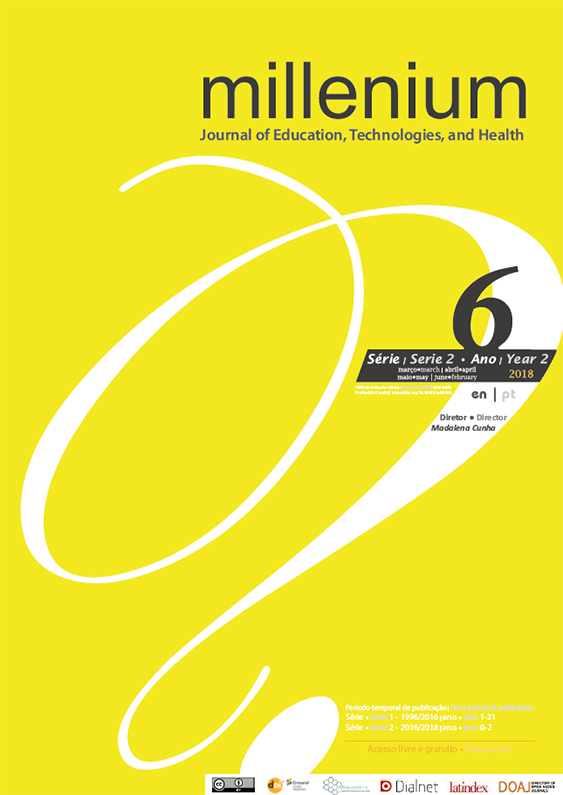Controlo da pressão arterial em mulheres idosas medicadas: benefícios do programa de exercício físico funcional
DOI:
https://doi.org/10.29352/mill0206.01.00178Palavras-chave:
Idoso, Atividade física, Hipertensão, EnvelhecimentoResumo
Introdução: A atividade física é recomendada para a prevenção e tratamento da hipertensão. A abordagem da intervenção promotora da atividade física funcional em um grupo de idosas hipertensas, deve ser caracterizada por uma intervenção holística face à pessoa. Esta consiste em considerar a pessoa na sua integridade física, psíquica e social.
Objetivo: Avaliar o efeito da implementação de um programa de treino funcional sobre a pressão arterial em repouso em mulheres idosas hipertensas, submetidas ao treino de exercício físico durante um período de 24 meses.
Métodos: Pesquisa exploratória, com orientação analítico-descritiva com a finalidade de analisar a ação da atividade física direcionada e implementada três vezes por semana no prognóstico da hipertensão arterial. Esta pesquisa foi suportada na recolha de dados da pressão arterial em repouso numa amostra de 60 idosas brasileiras na faixa etária de 60 a 90 anos da comunidade do Vergel do Lago, Maceió/AL, Brasil.
Resultados: A maioria das idosas é hipertensa (80%), constatando-se que durante o período de treino apresentaram pressão arterial sistólica e diastólica muito abaixo do padrão da normalidade para essa faixa etária.
Conclusões: Após a intervenção do Projeto Prevenção de Saúde Estádio Vivo, as idosas apresentaram redução e melhor controle dos valores da sua pressão arterial. Considera-se assim, que o treino físico ao exercer um efeito fisiológico específico ao nível muscular e cárdio-circulatório é protetor do estado de saúde pelo que deve ser incentivado ao longo de todo o ciclo vital. Infere-se também que o Programa implementado pode ser replicado como medida de educação terapêutica, de avaliação e de auditoria de boas práticas em saúde.
Downloads
Referências
American Heart Association & American Stroke Association (2014). Understanding and Managing High Blood Pressure. Acedido em: https://www.heart.org/idc/groups/heart-public/@wcm/@hcm/documents/downloadable/ucm_461840.pdf
Carrageta, M. (2006). Tudo o que deve saber sobre hipertensão arterial. Brochura-CRC- Nº 9. Lisboa: Fundação Portuguesa de Cardiologia. Acedido em http://www.fpcardiologia.pt/wp-content/uploads/2013/08/Brochura-CRC-N%C2%BA-9-Hip.-Art..pdf
(DeCS). Descritores em Ciências da Saúde (2018). Consulta ao DeCS. Acedido em <http://decs.bvs.br/>.
Direção Geral da Saúde (2013). Hipertensão Arterial: definição e classificação. Norma da Direção-Geral da Saúde. Acedido em: http://www.dgs.pt/?cr=21160.
Direção Geral da Saúde. Diagnóstico, Tratamento e Controlo da Hipertensão Arterial. (2004). (Circular Normativa Nº: 2/DGCG de 31/03/04.). Lisboa: Ministério da Saúde, DGS. Acedido em: http://www.dgs.pt/?mid=5005&cr=6824.
European Society of Hypertention & European Society of Cardiology (2013). Hypertention: Guidelines for the Management of Arterial Hypertention. Acedido em: https://www.escardio.org/static_file/Escardio/Guidelines/publications/AHWeb_EM_Hypertension_2013.pdf
Ferreira, P. L. (2012a). Qualidade de vida e diabetes. Boletim nº 4, Revista Sociedade Portuguesa de Diabetologia. Acedido em WWW:http://www.spd.pt/index.php?option=com_content&task=view&id=19&Itemid=107.
Ferreira, P.L. (2012b). Qualidade de vida e diabetes. Relatório de atividades da Sociedade Portuguesa de Diabetologia do Ano 2012, Boletim nº4. Acedido em: http://www.spd.pt/index.php/qualidade-de-vida-e-diabetes-mainmenu-107.
Malta; D., Scala, L. C. N. & Fuchs, S. (2017). Conceituação, Epidemiologia e Prevenção Primária In Malachias, M. V. B. 7ª Diretriz Brasileira de Hipertensão. Revista Brasileira de Hipertensão, 24: 1 - Acedido em: http://departamentos.cardiol.br/sbc-dha/profissional/revista/24-1.pdf
Medina, F.L., Lobo, F.S., Souza, D.R. de, Kanegusuku, H., & Forjaz,
C.L.M de (2010). Atividade física: impacto sobre a pressão arterial. Revista Brasileira de Hipertensão; 17(2): 103-106. Acedido em: http://departamentos.cardiol.br/dha/revista/17-2/10-atividade.pdf.
Nogueira, I.C., Santos, Z.M.S. de, Mont´Alverne, D.G.B.M., Martins, A.B.T., & Magalhães, C.B.A. de (2012). Efeitos do exercício físico no controle da hipertensão arterial em idosos: uma revisão sistemática. Revista Brasileira de Geriatria e Gerontologia; 15(3): 587-601. Acedido em: http://www.scielo.br/scielo.php?script=sci_arttext&pid=S1809-98232012000300019
Perk, J., De Backer, G., Gohlke, H., Graham, I., Reiner, Z., Verschuren, M., Albus, C., Benlian, P., Boysen, G., Cifkova, R., Deaton, C., Ebrahim, S., Fisher, M., Germano, G., Hobbs, R., Hoes, A., Karadeniz, S., Mezzani, A., Prescott, E., Ryden, L., Scherer, M., Syvänne, M., Scholte op Reimer, W.J., Vrints, C., Wood, D., Zamorano, J.L., Zannad, F. (2012). European Guidelines on cardiovascular disease prevention in clinical practice (version 2012): The Fifth Joint Task Force of the European Society of Cardiology and Other Societies on Cardiovascular Disease Prevention in Clinical Practice. Developed with the special contribution of the European Association for Cardiovascular Prevention & Rehabilitation (EACPR); ESC Committee for Practice Guidelines (CPG). Eur Heart J; 33(13):1635-701. doi: 10.1093/eurheartj/ehs092. Epub 2012 May 3.
Radovanovic, C. A. T., Santos, L. A., Carvalho, M. D. B., Marcon, S. S. (2014). Hipertensão arterial e outros fatores de risco associados às doenças cardiovasculares em adultos. Revista Latino -Americana de Enfermagem. 22(4):547-53. DOI: 10.1590/0104-1169.3345.2450. Acedido em www.eerp.usp.br/rlae
Silva, J.A., Martins, L., Carlos, J., Silva, C., & Veloso, L. (2010). Estudo Observacional Transversal Comparativo do Não Controlo de HTA em Doentes a Efectuar Monoterapia Versus Politerapia. Revista Portuguesa de Hipertensão e Risco Cardiovascular. Acedido em: http://www.eurotrials.com/publicacoes/articles-en/page/2/
Silva, M., Clinton, J., Appleton, S. & Flanagan, P. (2011). Diabetes self-management education in South Auckland, New Zealand, 2007-2008. Preventing Chronic Disease; 8 (2):A42. Acedido em: http://www.cdc.gov/pcd/issues/2011/mar/09_0207.htm.
Downloads
Ficheiros Adicionais
Publicado
Como Citar
Edição
Secção
Licença
Os autores que submetem propostas para esta revista concordam com os seguintes termos:
a) Os artigos são publicados segundo a licença Licença Creative Commons (CC BY 4.0), conformando regime open-access, sem qualquer custo para o autor ou para o leitor;
b) Os autores conservam os direitos de autor e concedem à revista o direito de primeira publicação, permitindo-se a partilha livre do trabalho, desde que seja corretamente atribuída a autoria e publicação inicial nesta revista.
c) Os autores têm autorização para assumir contratos adicionais separadamente, para distribuição não-exclusiva da versão do trabalho publicada nesta revista (ex.: publicar em repositório institucional ou como capítulo de livro), com reconhecimento de autoria e publicação inicial nesta revista.
d) Os autores têm permissão e são estimulados a publicar e distribuir o seu trabalho online (ex.: em repositórios institucionais ou na sua página pessoal) já que isso pode gerar alterações produtivas, bem como aumentar o impacto e a citação do trabalho publica
Documentos necessários à submissão
Template do artigo (formato editável)















